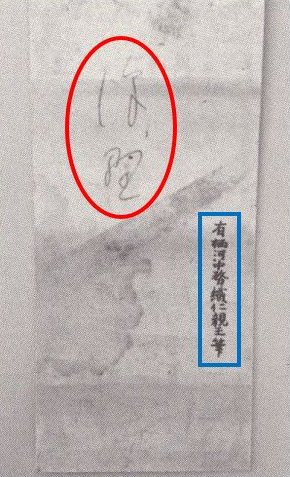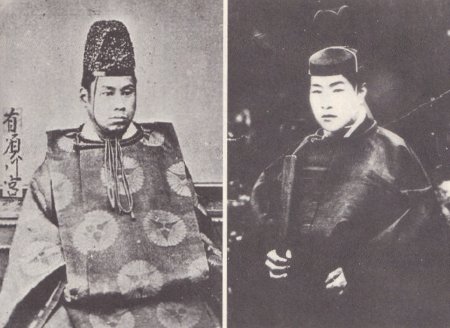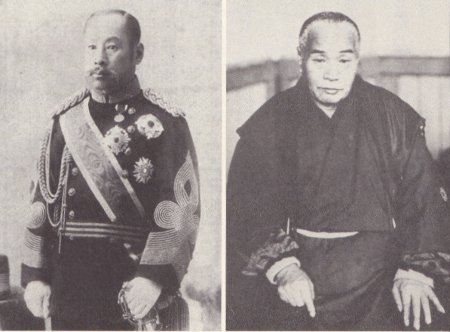|
First published: December 27, 2009
Last updated: September 29, 2023
Prince Taruhito's handwritten poem was rediscovered!
There is a passage in Mother Earth, a true story about Onisaburo, that describes how Imperial Prince Taruhito of the House of Arisugawa comes to give Yone (Onisaburo's mother) a strip of fancy tanzaku paper with a 31-syllable waka poem he composed for her.
 Prince Taruhito, the biological father of Onisaburo
This tanzaku had been missing for years. But in 2009 it was discovered at the residence of Ms. Naomi Deguchi, the divinely appointed Fourth Spiritual Leader of Omoto.
The discovery of Arisugawa's tanzaku (see below) is extremely important because it proves that Prince Taruhito was Onisaburo's biological father. Onisaburo had the Imperial blood running through his veins.
 Prince Taruhito's handwritten tanzaku (right: front side; left: back side)
The poem on the tanzaku reads:
Wa ga ko i wa
Mi ya ma ga ku re no
Ku sa na re ya
Shi ke ki ma sa re to
Shi ru hi to no na ki
The above can be interpreted to mean:
The baby to be born from my romance is of noble status and deserves a life in the Imperial Palace. But it will be thrown as a grain of seed into the remote grassy countryside that conceals all the secrets. No matter how well it will grow up and become known to the world, no one will recognize its true identity. How lamentable!
The above 31-syllable waka is slightly different from the one in Mother Earth (see below) because when the novel was published, the tanzaku was still missing, and because Mr. Yasuaki Deguchi, the author of the novel, based his information on Onisaburo's youngest daughter, who remembered the poem she had seen in the past:
Wa ga ko i wa
Mi ya ma no o ku no
Ku sa na re ya
Shi ge sa ma sa re do
Shi ru hi to zo na ki
[Translation]
My romance is grass in a deep mountain recess
Though growing lush with passion, it is left unnoticed.
A close examination of the tanzaku's back side reveals Prince Taruhito's message (red circle) dissuading Yone from bringing their love child to the Imperial Court for fear of being killed. The blue rectangle shows probably Onisaburo's handwriting later added to the tanzaku. It seems that he intentionally misspelled Prince Taruhito's name and wrote it somewhat illegibly to hide the authenticity of the prince's tanzaku if it is confiscated by the authorities.
 A close-up of the tanzaku's back side
 Younger Prince Taruhito (left) and younger Onisaburo (right)
 Older Prince Taruhito (left) and older Onisaburo (right)
The rediscovered tanzaku will help clear Onisaburo's reputation.
Until the end of World War II, the imperialistic Japanese authorities often accused Onisaburo of being a 'traitor,' 'insurgent' or 'fraudster' who plotted a rebellion against the Emperor, and branded his Omoto as an abode of demons because the state's hawkish authoritarianism ran counter to Onisaburo and Omoto's pacifism. In fact, the government launched a nationwide crackdown on Omoto and its local churches to 'wipe out Omoto from the face of the Earth' (The Second Omoto Incident of 1935).
Onisaburo and other senior adherents were put in jail while the state spread disinformation about Onisaburo and his religious group, such as pornographic pictures the police arranged in Onisaburo's residence and had the media take photos of. The state-sponsored negative campaign worked so well that even today some Japanese people, especially those in older generations, tend to have a negative view of Onisaburo and Omoto. The Japanese media also seem to see Onisaburo as a taboo subject because the public has been misled to believe that Onisaburo attempted to usurp the Chrysanthemum Throne, which is totally groundless.
The discovery of Prince Taruhito's fancy paper verifies that Onisaburo was a child of the Prince and an heir to the imperial throne. In fact, Prince Taruhito was first in line to the imperial throne from the end of the Edo period to the early Meiji era. If history had taken a different path, Onisaburo could have become the Emperor! But history did not pan out like that because of the conspiracy associated with "two Emperor Meiji's." Before going into detail, please take a look at the following poems:
 |
The 4th highlighted row (right to left) says: "Ayabe ni tenshi wo kakuseri " (The true emperor is hidden in Ayabe)
The 8th highlighted row (left to right) says: "Imano tenshi nisemono nari " (The current emperor is a false one)
|
Onisaburo secretly embedded a message in a dozen of 12-syllable poems for Omoto's missionary work (see above). His message means that he would have been the genuine emeperor - at lease genealogically.
Onisaburo had to use this method because in those days the Emperor was deified as an inviolable being, and any open criticism of him would trigger punishment for a charge of lese majeste.
By "Ayabe ni tenshi wo kakuseri " (The true emperor is hidden in Ayabe), Onisaburo hints that he IS the true emperor. Please note that he is not a megalomanic nor does he let his imagination run wild. His message is based on the truth. Onisaburo is an illegitimate son of Prince Taruhito of the House of Arisugawa. Prince Taruhito was first in line to the imperial throne until Prince Yoshihito (= Emperor Taisho in the future) was born, and since Prince Taruhito had no children, Onisaburo could have been appointed emperor.
|
| |
